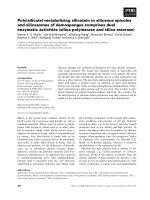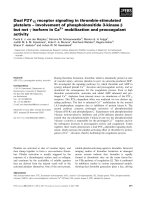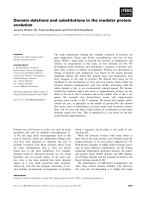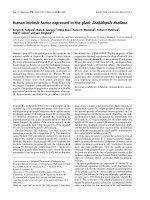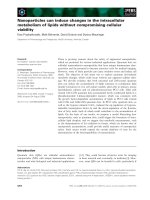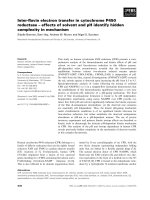Báo cáo khoa học: "Idiopathic intranuclear inclusion bodies in the renal tubular epithelia of Japanese quail (Coturnix coturnix japonica)" pot
Bạn đang xem bản rút gọn của tài liệu. Xem và tải ngay bản đầy đủ của tài liệu tại đây (1.01 MB, 2 trang )
-2851$/ 2)
9H W H U L Q D U \
6FLHQFH
J. Vet. Sci.
(2005),
/
6
(1), 75–76
Idiopathic intranuclear inclusion bodies in the renal tubular epithelia of
Japanese quail (
Coturnix coturnix japonica
)
Seung-Hyeok Seok, Jong-Hwan Park, Sun-A Cho, Jae-Hak Park*
Department of Laboratory Animal Medicine, College of Veterinary Medicine, Seoul National University, Seoul 151-742, Korea
We report idiopathic intranuclear inclusion bodies in
the renal tubular epithelia of two cases of among the 960
Japanese quail (
Coturnix coturnix japonica
) in the course
of the acute oral toxicity and dietary toxicity test.
Basophilic inclusion bodies were seen only in the nuclei of
renal tubular epithelia. We could not classify our case into
any adenovirus infection by clinical signs and lesions. The
inclusion bodies were only identified as adenovirus-like
particles based upon the electronmicroscopical features.
Key words:
Adenovirus-like particles, Japanese quail (
Coturnix
coturnix japonica
), Inclusion body
Intranuclear inclusion bodies in the renal epithelium of
birds are usually caused by viruses; inclusion body hepatitis
virus (avian adenovirus-1) or haemorrhagic enteritis virus
(avian adenovirus-2) [5,7]. Here, we found two cases of
idiopathic intranuclear inclusion bodies in the renal tubular
epithelia among the 960 Japanese quail (
Coturnix coturnix
japonica
) in the course of the acute oral toxicity and dietary
toxicity test.
Althouh we could not classify present case into
virus infections by clinical signs and lesions, we report the
characteristic features of the idiopathic intranuclear
inclusion bodies.
Nine hundred and sixty male and female 6-week-old
Japanese quail (Coturnix coturnix japonica) weighing 130-
150 g were obtained from a local supplier (Suwon-Ezo,
Suwon, Korea). All animal experiments were performed
under protocols approved by Institutional Animal Care and
Use Committee of Seoul National University. The quail
were kept at room temperature of 22
±
2
o
C and 55
±
10%
relative humidity, and received 8/16 h of light/darkness with
light intensity of 300 lux. Air changes per hour were kept
constant (15X). The birds received standard layer feed
(Samyang, Korea) and tap water
ad libitum
.
The brain, liver, kidney, thymus, lung, spleen, trachea,
intestine, testis, and ovary were fixed in 10% neutral
formalin at least for 24 h when the acute and dietary toxicity
tests were finished, dehydrated in alcohol xylene series, and
embedded in paraffin wax. From each block, 2 mm-thick
sections were prepared, and stained with haematoxylin and
eosin for histopathological examination. Haematoxylin and
eosin stained kidney containing number of inclusion body
was selected for transmission electron microscopic
evaluation. The selected portion was post-fixed in 1% OsO
4
,
and rinsed with 0.1 M sodium cacodylate buffer (pH 7.2) for
30 min
in situ
. After dehydration in a series of alcohol-
propylene oxide, the sections were embedded in an epon
mixture (Quetol 812, DDSA, MNA, DMP 30) at 60
o
C.
Ultrathin sections were double-stained with 1% uranyl
acetate and 1% lead citrate, and examined with an electron
microscope (JEM 100CX , JEOL, Japan) at an accelerating
voltage of 80 KV.
The intranuclear inclusion bodies were detected in the
tubular epithelia of two cases of among the 960 quail
examined. These quail were from control group and showed
no general clinical signs of disease throughout the course of
the experiment. The inclusions were homogenous and
basophilic (Fig. 1). The dimensions of the inclusion bodies
were 19.1
±
2.2
µ
m (range 16.2 to 22.5
µ
m; n = 30).
Inclusion bodies were not found in the cytoplasm, but were
only observed in the renal cortex. Ultrastructurally, the
inclusion bodies were consisted with electron-dense
particles (Fig. 2). The particles were nonenveloped
hexagonal outline and assembled in the nucleus. The
diameter of the particles was 70 nm in regular size.
Electronmicroscopically, the idiopathic intranuclear
inclusions were thought as adenovirus-like particles based
upon the morphology and size. These inclusion bodies were
seen only in the renal tubular epithelia. Singh
et al.
inoculated experimentally with inclusion body hepatitis
virus (avian adenovirus-1) derived from quail to Japanese
quail and reported large basophilic intranuclear inclusion
bodies were seen in hepatocytes and occasionally in the
renal epithelium. Lesions were most frequently encountered
*Corresponding author
Tel.: +82-2-880-1256; Fax: +82-2-880-1256
E-mail:
Short Communication
76 Seung-Hyeok Seok
et al.
in the liver, kidneys and lungs. Pale, swollen and mottled
liver, swollen nephritic kidneys, and congestion and
pneumonia lungs were included in lesions [7]. However, it
was distinguished from our report by the lesions; the
inclusion bodies were observed only in the kidney, not in the
liver. In addition, no clinical signs were observed in our case.
Turkey, pheasants, and chickens were only known to be a
natural host to adenovirus-2 infection. It is now suspected
that guinea fowl [1,4] and psittacines [3] may also be
naturally infected with adenovirus-2. To our knowledge,
there was no reported case of natural adnovirus-2 infection
in quail up to present. Also the clinical signs of haemorragic
enteritis, marble spleen disease, and related infections are
different from our report [2,6].
Spontaneous idiopathic intranuclear inclusion bodies in
the renal tubular epithelia were rarely reported and we
hardly classify our case into any adenovirus group. The
characteristic features of the inclusion bodies reported here
are their intranuclear location, basophilic, homogeneity in
size and occurrence only in the renal cortical epithelium.
Acknowledgments
This work was supported by the Brain Korea 21 Project,
Korea.
References
1. Cowen BS, Rothenbacher H, Schwartz LD, Braune MO,
Owen RL. A case of acute pulmonary edema, splenomegaly,
and ascities in guinea fowl. Avian Dis 1988, 32, 151-156.
2. Domermuth CH, Gross WB. Hemorrhagic enteritis and
related infections. In: Hofstad MS, Barnes HJ, Calnek BW,
Reid WM, Yoder HW Jr (eds.). Diseases of Poultry. 8th ed.
pp. 511-516, Iowa State University Press, Ames, 1984.
3. Gomez-Villamandos JC, Martin de las Mulas JM, Hervas
J, Chancon-M de Lara F, Perez J, Mozos E. Spleno-
enteritis caused by adenovirus in psittacine birds: A
pathological study. Avian Pathol 1995, 24, 553-563.
4. Massi P, Gelmett D, Sironi G, Dottori M, Lavazza A,
Pascucci S. Adenovirus-associated haemorrhagic disease in
guinea fowl. Avian Pathol 1995, 24, 227-237.
5. Meteyer CU, Mohammed HO, Chin RP, Bickford AA,
Trampel DW, Klein PN. Relationship between age of flock
seroconversion to hemorrhagic enteritis virus and appearance
of adenoviral inclusions in the spleen and renal tubule
epithelia of turkeys. Avian Dis 1992
,
36, 88-96.
6. Pierson FW, Barta VD, Boyd D, Thompson WS. The
association between exposure to multiple infectious agents
and the development of colibacillosis in turkey. J Appl
Poultry Res 1996, 5, 347-357.
7. Singh A, Oberoi MS, Singh B. Pathologenicity of quails
inclusion body hepatitis virus (avian adenovirus-1) for
Japanese quails and broiler chicks. Vet Res Commun 1995,
19, 545-551.
F
ig. 1. Intranuclear inclusion bodies in the renal epithelium of
a
J
apanese quail (Arrowheads). H&E stain; bar = 25
µ
m.
F
ig. 2. The haematoxylin and eosin stained tissue sections we
re
p
repared for electron microscopy
in situ
. The inclusion bodi
es
w
ere identified as assemble of adenovirus-like particles; bar
=
3
50 nm.
